Buffalo MiniStation Thunderbolt Review - An External with USB 3.0 and Thunderbolt
by Brian Klug on August 1, 2012 4:04 PM EST- Posted in
- Storage
- SSDs
- USB 3.0
- Thunderbolt
- Buffalo
To test the MiniStation Thunderbolt I turned to a combination of Intech’s QuickBench and the BlackMagic Disk Speed Test application from the Mac App store. I tested on my 2011 MacBook Pro, which has a first generation Light Ridge Thunderbolt controller inside. For testing on OS X, I used native HFS+ formatting for the MiniStation.
| BlackMagic Disk Speed Test - 2011 MBP | |||||||
| 500 GB HDD | 240 GB OCZ Vertex 3 | ||||||
| Read (MB/s) | Write (MB/s) | Read (MB/s) | Write (MB/s) | ||||
| USB 2.0 | - | - | 28.4 | 34.7 | |||
| Thunderbolt | 112.5 | 110.9 | 269.8 | 370.5 | |||
There’s no USB 3.0 on my 2011 MacBook Pro, so for USB 3.0 I turned to my desktop which has a Renesas based USB 3.0 controller, and reformatted the drive to NTFS. I used CrystalDisk Mark to test.
With the HDD inside, you basically get the kind of speeds you’d expect were the drive connected natively over SATA. Keep in mind, with the 1 TB HDD, speeds will actually be slightly higher thanks to the higher storage density.
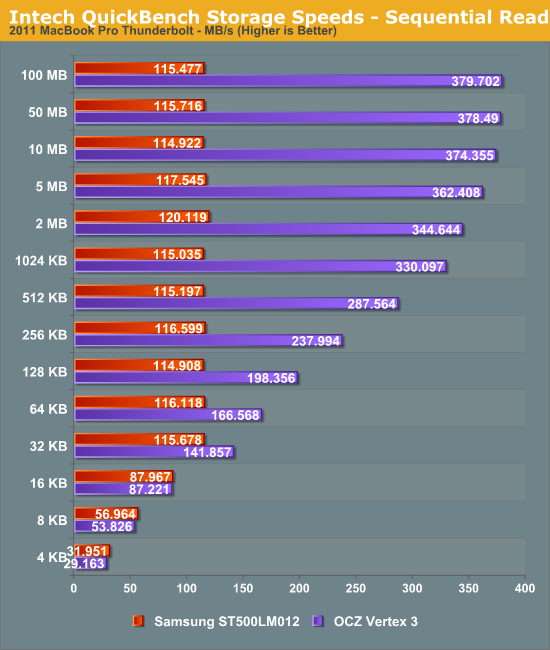
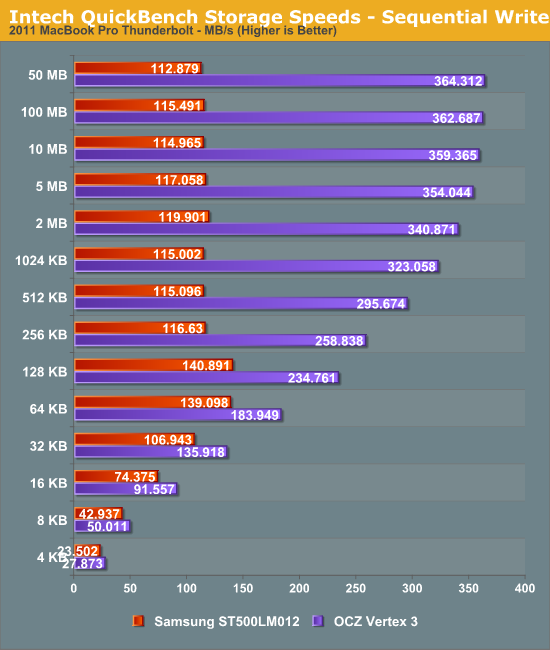
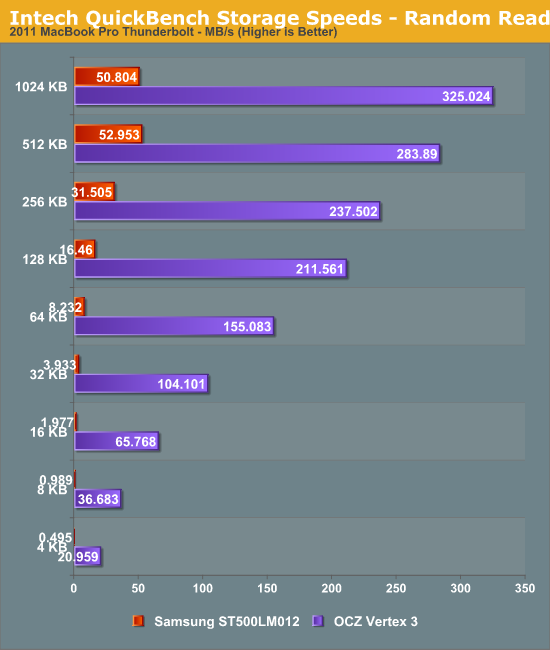
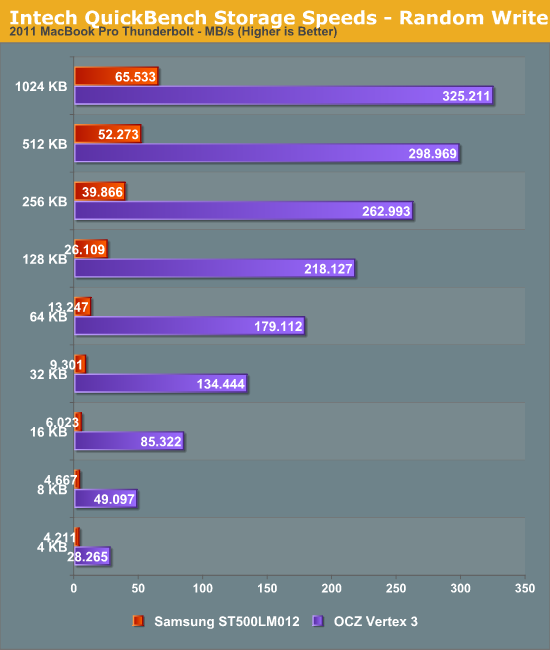

Looking at the QuickBench scores, the Vertex 3 performs just as well inside the MiniStation as it does connected to a 6Gbps SATA controller in our Bench test bed.
When connected over Thunderbolt on OS X, in System Profiler you can see the drive attached over an AHCI controller just like any internal drive, and with TRIM enabler patched kexts on OSX you can even TRIM the SSD. Buffalo has no plans to sell a bare external enclosure for people to stick their own SSD in, but at the current price point upgrading it yourself is a pretty viable option.
In addition to stressing the drive with the BlackMagic Disk Speed Test app set to 50 GB, I filled the stock HDD with random data by running good ol’ dd with data from /dev/urandom, a favorite test of mine for all storage that comes my way. Just run “dd if=/dev/urandom of=test.bin” in the root of the drive, and let it fill up. The drive’s aluminum underside does a great job conducting heat away, and gets somewhat warm (after all, it is doubling as a heatsink, and aluminum has great thermal conductivity) during use. Even with hours of constant Thunderbolt and HDD access, the drive didn’t overheat or disconnect at all with the HDD inside. I’ve also stressed the drive with the SSD inside (an unsupported configuration) and didn’t encounter any issues.
Anand noted in his original Thunderbolt piece that the cable connectors at the endpoints get warm, and measured 27.6C at the end of a cable. I ended up measuring a notably warmer temperature of over 35C during my stress testing of the drive, but my ambient temperature in AZ is also hotter than Anand’s in NC. When you consider that there’s an active component at the end of both sides of the cable (a Gennum GN2033), this isn’t altogether surprising, but it is disconcerting to feel the cables get noticeably warm during use.


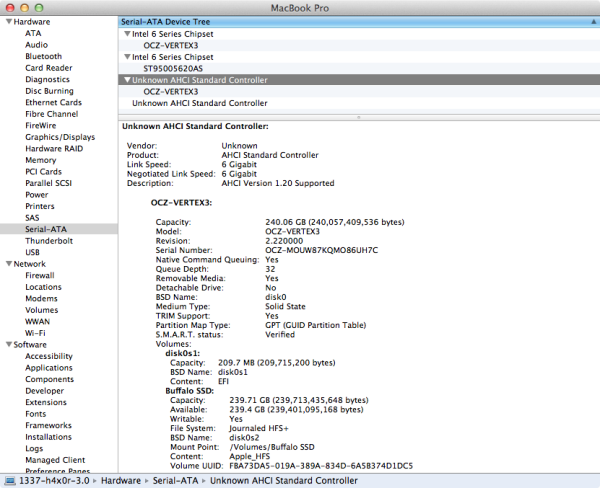









61 Comments
View All Comments
Guspaz - Wednesday, August 1, 2012 - link
This is still a $100-130 premium over comparable USB 3 drives of the same capacity, which is just nuts. It's the same kind of markup Seagate charges (the thunderbolt goflex adapter goes for about $130).This is silly: Apple has a thunderbolt ethernet adapter out for $29, which means the cost of the controller is below $29, and you can buy a card with a PCIe SATA controller for $15. Both of those would already have markup on them for the profit margin, so the premium for a thunderbolt external HDD should be LOWER than $44... Instead the premium is almost three times higher.
PRPechek - Wednesday, August 1, 2012 - link
I would have to disagree with you. The Thunderbolt Ethernet Adapter does not have a Thunderbolt controller. At this link:http://www.hardmac.com/news/2012/06/21/inside-appl...
You can see a tear down of the TBEA and Apple is not using Intel’s Thunderbolt-to-PCIe chipset. Instead, the Broadcom chip is directly connected to the Thunderbolt cable and it is just working as a cable transport layer. By design, the Thunderbolt "controller" is actually mapping one or more PCI-Express lanes directly over the cable, so that the MAC+PHY solution itself only needs speak PCI-Express and only requires the Thunderbolt PHY.
Note: that I cut and pasted almost all of the above from Stephen Foskett great breakdown of the TBEA chipset. http://blog.fosketts.net/2012/07/03/apple-thunderb...
But as you can see on the second page of this review Buffalo has a quite a few chipsets imbeded into the PCB to make a workable dual port solution and that raises that raises the BOM costs. Seagate's solution has a similar situation with their solution.
(Full disclosure: I work for Buffalo Technology)
Olaf van der Spek - Wednesday, August 1, 2012 - link
So why can't you do a TB - SATA bridge without TB controller as well?What's the advantage of TB over USB3 if you merely want to connect a single HDD?
ggathagan - Wednesday, August 1, 2012 - link
Your first question is not clear.TB requires a TB controller on both ends of the cable, so the TB controller is going to be there no matter what.
Intel is the only company that makes TB controllers, so how would you create a TB-SATA bridge without the controller?
There's no advantage to TB over USB3, unless you have a MacBook Air, MacBook Pro, Mac mini, or iMac that has no USB 3 support.
name99 - Wednesday, August 1, 2012 - link
"There's no advantage to TB over USB3"It appears that there is a substantial speed advantage --- almost 2x.
Look at the numbers: 200MB/s or so for sequential USB3, 370 MB/s or so for sequential TB.
This may or may not be worth $130 to you, but let's not pretend that the two are identical.
Lonyo - Thursday, August 2, 2012 - link
You must be missing the part where that only applies to an SSD put in after the fact.With the stock drive which comes as part of the unit, the speeds are equal at around 115~120MB/s.
There is no performance difference between this drive when used with Thunderbolt, and when used with USB3.
And if you're getting an SSD to put in an enclosure, the difference becomes the difference between an empty USB3 enclosure, and one of these, which means it's more like $170+, since you can get an empty USB3 eternal enclosure for around $30, while you can't get just a Thunderbolt enclosure, so you have to pay $200 for the 500GB drive.
As shipped, with a mechanical harddrive in it, this drive is identical in performance to a USB3 external enclosure with no Thunderbolt. And $110+ more expensive.
lin2log - Thursday, August 2, 2012 - link
And you must be missing (actually ignoring) the very simple original question: "What's the advantage of TB over USB3", which I don't see somehow applies to any one disk or peripheral, but rather is about the port ITSELF, so your insertion is completely irrelevant.But I like how the question is quickly limited to "if you merely want to connect a single HDD", which makes it a nonsensically loaded question.
Simple: if you don't see the advantages for you... DON'T USE IT. Duuuuh...
ssj3gohan - Thursday, August 2, 2012 - link
You seem to imply that his comments are not valid, but that is not true at all. He has extremely valid points. What use is a proprietary interface with monstrously expensive interconnects, controllers, almost no second suppliers and no performance, power consumption, ANY advantage whatsoever? You're just paying a hell of a lot more for nothing. It's a big design flaw on Apple's side that there is apparently no USB 3 on some of their products, because that interface is obviously far superior except for some niche applications. They can promote the niche applications, sure, just make sure you can also plug in more conventional stuff. That's what expandability is all about.mavere - Thursday, August 2, 2012 - link
"What use is a proprietary interface with ... almost no second suppliers and no performance, power consumption, ANY advantage whatsoever?"Patently false. As you have the benefit currently reading a TB review, you may scroll up and look at the SSD numbers.
Cheers.
AnnonymousCoward - Thursday, August 2, 2012 - link
ssj3gohan is 1000% correct.